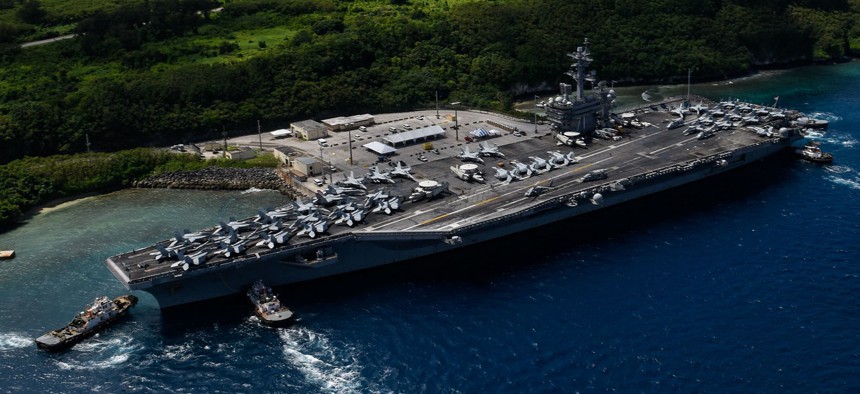
The aircraft carrier USS Roosevelt departs Guam in November 2017. Mass Communication Specialist 3rd Class Anthony J. Rivera
Navy Evacuates Aircraft Carrier Infected by Coronavirus
"The spread of the disease is ongoing and accelerating,” Capt. Brett Crozier wrote to service leaders seeking urgent help.
The U.S. Navy has begun removing the majority of USS Theodore Roosevelt's crew so the aircraft carrier can be disinfected, two days after its commanding officer sent an urgent message asking for help controlling a COVID-19 outbreak.
About one-fifth of the 4,865 sailors are off the aircraft carrier and into isolation on Guam, with about 2,700 more expected to evacuate in the next few days, Acting Navy Secretary Thomas Modly said Wednesday.
In a Tuesday interview with CNN, Modly said, “The key is to make sure that we can get a set of crew members that can man all those critical functions on the ship, make sure they’re clean, then get them back on while we clean the ship and get the other crew members off ... And that’s the process we’re going through. It’s very methodical. We’re absolutely accelerating it as we go.”
The 1,100-foot Theodore Roosevelt tied up in Guam on Friday after several sailors were discovered to be infected. On Monday, Capt. Brett Crozier sent an extraordinary four-page letter asking for Navy help. His warship has no space to give infected patients a separate berthing space and bathroom, so he asked for assistance finding rooms ashore.
"The spread of the disease is ongoing and accelerating,” Crozier wrote in the March 30 letter, which was obtained by the San Francisco Chronicle. "Decisive action is required.”
Crozier recommended isolating or quarantining more than 4,000 sailors for two weeks to ensure that no one carries the virus back aboard. Meanwhile, about 10% of the crew would be needed to run the ship in port and disinfect it, he wrote.
“Keeping over 4,000 young men and women on board the TR is an unnecessary risk and breaks faith with those Sailors entrusted to our care,” the captain wrote.
In the CNN interview, Modly said, "We've been working the past several days to get those sailors off the ship and to get them into accommodations in Guam. The problem is that Guam doesn't have enough beds right now, so we're having to talk to the government there to see if we can get some hotel space, or create some tent-type facilities there."
In a conference call with reporters early on Tuesday evening, Pacific Fleet commander Adm. John Aquilino said, “We understand the [CO’s] request. We’ve been working it in advance, continue to work it and I’m optimistic that the additional quarantine and isolation capacity that’s being discussed will be delivered shortly."
Aquilino underscored that some portion of the crew would remain aboard.
"I need to be able to run the [nuclear] reactors, fight fires, do damage control, feed the crew that’s aboard. All of those things are a requirement and the team is working through how to do that while at the same time executing our approach to generating fully healthy and COVID-free sailors," he said.
Ninety sailors have tested positive for the novel coronavirus, while 593 have tested negative and several hundred tests are still pending, Modly told reporters Wednesday. About one-quarter of the crew has been tested so far. None of the sailors has yet required hospitalization for the disease, he said.
About 1,000 sailors will remain aboard the Roosevelt to run its nuclear reactors, oversee its weapons, and keep the ship running, said Adm. Michael Gilday, chief of naval operations, at a Pentagon press conference.
Modly said that testing aboard the Roosevelt was initially limited to about 200 sailors per day. He said that will soon be increased by sending tests elsewhere for processing.
A tougher environment to disinfect can scarcely be imagined. A Nimitz-class carrier has more than 3,000 spaces — “rooms,” to non-sailors — that hold all manner of complicated and dangerous machinery, up to and including nuclear reactors.
In his letter, Crozier wrote that the carrier could still go into battle and win, because “in combat we are willing to take certain risks that are not acceptable in peacetime. However, we are not at war, and therefore cannot allow a single Sailor to perish as a result of this pandemic unnecessarily.”
The Roosevelt and its associated battle group departed San Diego on Jan. 17 and was amid a deployment to the western Pacific when its first crew member was found to have COVID-19. No one knows how the coronavirus got onto the ship. Modly said all sailors returning from an early-March port visit in Danang, Vietnam, were tested and found negative for the virus. The first two sailors to develop COVID symptoms did so 14 days after the ship left Danang, he said.
Meanwhile, Navy leadership is having twice-daily conversations with its 3- and 4-star officers on what the fleet should know and be doing about the coronavirus outbreak, Gilday said. The Navy has cancelled some exercises and training operations. Ships are required to have their crews aboard for 14 days of isolation before leaving on a deployment. And although consistent social distancing is impossible aboard a warship, the CNO has told ship and submarine captains to “be creative” in designing ways to reduce contact between sailors, by altering procedures for standing watch or other methods.
Marcus Weisgerber contributed to this report. This story was updated with new information after it was first posted Wednesday morning.
Related podcast:







